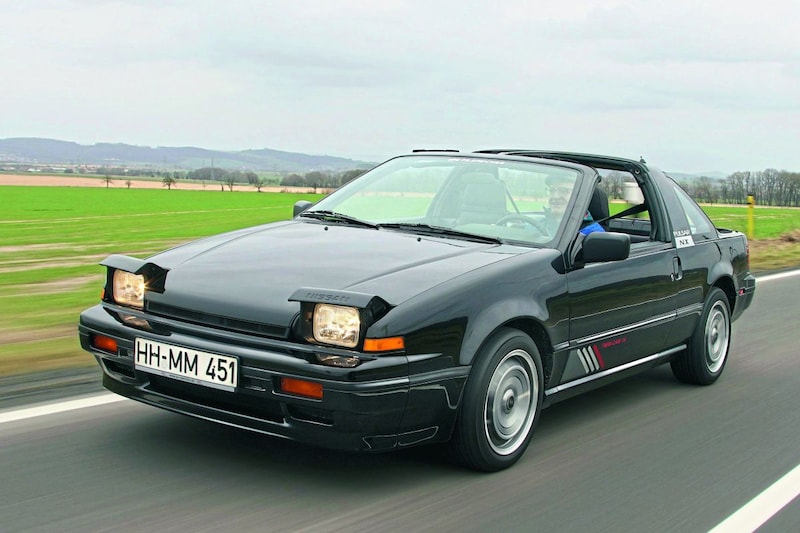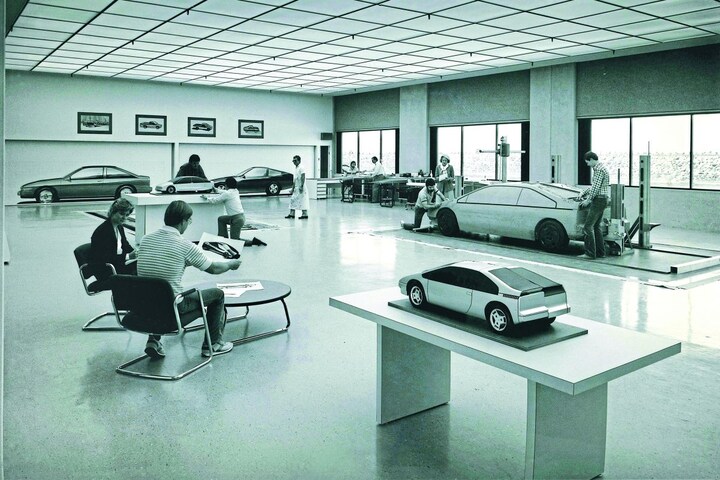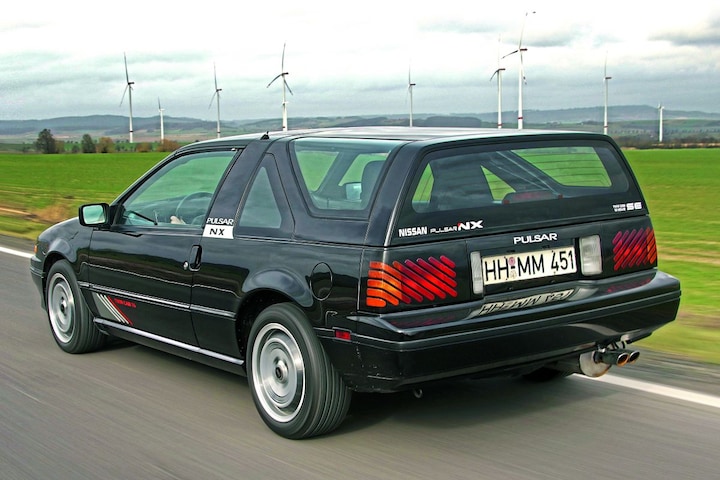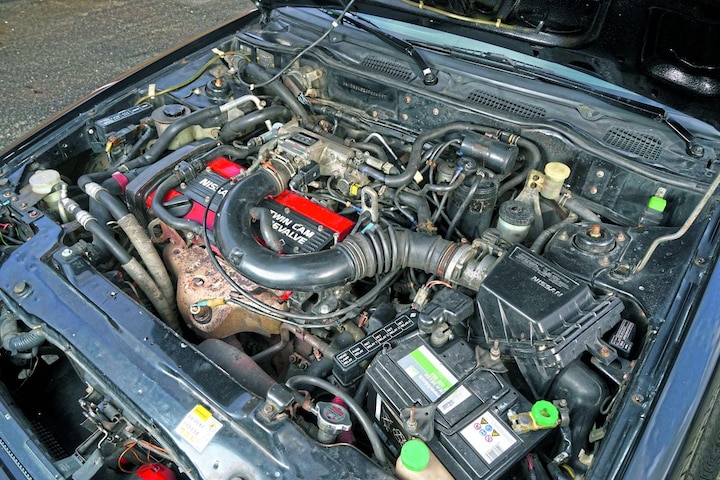

A station wagon? A coupe? A convertible? The Nissan Pulsar NX (1986 to 1990) can be anything. You just have to convert it.
How did the people at Nissan come up with the idea to develop this car? Were they in a meeting and someone from the product development department came up with a proposal? “Our market research shows that most customers dream of a sports car, a coupe or a convertible, but ultimately buy a station wagon.” The answer from the other attendees was undoubtedly that you cannot change much about that. But the product developers didn’t just leave it at that. “With the import restrictions in the US, it is actually not interesting for us to build cheap cars in mass production, it would be better to sell more expensive cars with a larger profit margin.” Well, of course the bigwigs were interested in that. “Moreover, many people would like to spend more time with their partner, for example on shared hobbies. We found a way to solve all these problems at once.”

Nissan’s product developers are said to have subsequently presented the concept of the Pulsar NX from the N13 series. At first glance it is a cool little coupe with retractable headlights, just like its predecessor N12. Again based on Golf competitor Sunny, which was in the showroom in North America as Pulsar. The special thing about this proposal is that the tailgate of the coupe extends to the roll bar, which you can remove and then drive without a tailgate. Even more practical would be the option to rotate the rear window under the tailgate, but that would probably have become a (too) expensive joke.
Station wagon
Instead of the coupe tailgate, you could screw on a large tailgate. Then the coupe suddenly turns into a station wagon. The difference, however, is that the model does not have a narrow tailgate, but that the entire rear part of the roof swings up together with the rear side windows when you open the hatch.
The product expert had not promised too much: the conversion is – in principle – conducive to human interaction, because even though on paper it looks as easy as the Playmobil police car, in reality even Arnold Schwarzenegger cannot implement the conversion get it done on his own. You need two or even three people to do the job. You take the tools from the spare wheel well and it takes sixteen steps to replace the valve, including replacing the various gas pressure dampers. The most important market was still the US, the country where drivers already took their Mercedes SL to the workshop, so to speak, to have the soft top opened or closed.

If the person leaning comfortably against the roll bar with the 14mm wrench gives the other two directions long enough and lets them do the hard work for them, they can save themselves a trip to the gym. Whether such situations benefit relationships with fellow human beings is highly questionable.
Well, we’re exaggerating somewhat. Assembly is actually very simple, once you get the hang of it. We have now been able to try it ourselves, although Nissan has never sold the model in our country. We spotted this copy at the PS.Speicher stand during the Bremen Classic Motor Show and then kindly asked if we could go out with it sometime.
Multiple brake lights
In addition, the PS.Speicher employees were kind enough to lug the heavy parts up and down and back and forth, so it was mainly our job to register. For example, we discover that in this car model the shape of the rear seems to be adapted to the shape of the interior mirror. There is even a brake light on the top of the roll bar. As soon as you close the tailgate, the light goes off and the one in the rear window comes on, so that the interior is not bathed in red light when driving in the dark. In addition, we notice that the headroom on the back seat is quite okay if you are approximately 1.40 meters tall and therefore do not have your head stuck under the roll bar. but even then you can still hit the brake light with your skull.

But let’s get back to the birth process. Creative Nissan employees developed the car and the exterior design was fine-tuned at Nissan Design International (NDI) in La Jolla, a San Diego neighborhood just southeast of Los Angeles. The design studio had only just opened in 1980. The core team consisted of Koichiro Kawamura, ex-Buick designer Allan L. Flowers, Doug Wilson and Bruce Campbell, led by Gerald ‘Jerry’ P. Hirshberg or Hirschberg (the sources contradict each other), one of the inventors of the Pontiac GTO and the Buick Riviera ‘Boattail’. The interior design was created on the other side of the Pacific Ocean. To be precise, in the Japanese prefecture of Kanagawa, southwest of Tokyo. The Pulsar NX was called the Nissan EXA in Japan and had an oil pressure indicator and a voltmeter as a right-hand drive model, but not as a left-hand drive model. You will only accidentally end up in a television quiz and be asked the question…

Diagonal stripes
In the early and mid-80s, diagonal, parallel stripes were mandatory worldwide, it seems. You would almost think there was a UN styling resolution on this subject. While the Volkswagen designers limited themselves modestly to steering levers and seat upholstery, the Nissan designers applied the design theme unbridled to the rear lights (of the NX-21 study model from 1983), the covers of the JBL speakers and (you just have to say just see) the pedal rubbers. In the commercials, a woman wearing a striped blouse, striped glasses and striped earrings drove away from a striped building and then through a striped landscape.
If the door handles look familiar: no, they are not from the Fiat Panda, they just look similar. Those door handles, the associated doors and the seats are pretty much everything that was put into series production after the presentation of the mid-engine study model MID4-I in 1985. In series production, the rear of the ‘Sportbak’ was always gray, but probably Many copies were later repainted in the body color.
For older car enthusiasts, pop-up headlights alone are a reason to covet a car model. Car nerds who love pop-up headlights will undoubtedly enjoy two special details of the Pulsar. Firstly, the brand name is molded into the ‘eyelid’ of the left headlight. Anyone who spontaneously gets a nervous twitch when it comes to flip-up headlights can appreciate this kind of asymmetrical detail. Another special feature: with a button at the top right of the steering wheel you can also fold and unfold the headlights without turning them on.

Not spectacular
But the best part is: you can actually drive it. And the Nissan does that very well, then it suddenly becomes a normal car. A transversely mounted four-cylinder engine is responsible for the drive. Usually it is a 1.6-liter with 8, 12 or 16 valves, our black racer has a 1.8-liter with 125 hp on board. It accelerates smoothly to 7,000 rpm, but it never becomes truly spectacular. The seating position is quite low, the power steering responds fairly immediately. The gearbox shifts very accurately, but has quite long shift paths. And a whining reverse gear.
The chassis responds predictably, also at the rear thanks to the independent suspension. The all-round visibility is very good, only the thick B-pillars get in the way. You can tell that the NX is now a classic car. The window cranks also remind you of this.
Someone in North America was once injured by the tailgate’s gas pressure damper. According to reports in Japan, Nissan then secretly removed the interchangeable tailgate from the delivery program. And in Japan? Someone must have missed the registration of the Pulsar NX with all its valves at the local RDW from the start. When Nissan came back with the station wagon tailgate after the EXA was homologated for the first time, the person from the authorities kindly refused to homologate this tailgate as well. “I can register the vehicle with the station wagon rear as a different model,” he said. That seemed like a nice solution. “But it did mean that you are officially not allowed to mount the station wagon rear end on the coupe. The valves should not be interchangeable,” the zealous official added. So the idea died an early death in Japan. And so the successor, the Nissan 100 NX, again had a permanently mounted tailgate.
– Thanks for information from Autoweek.nl




